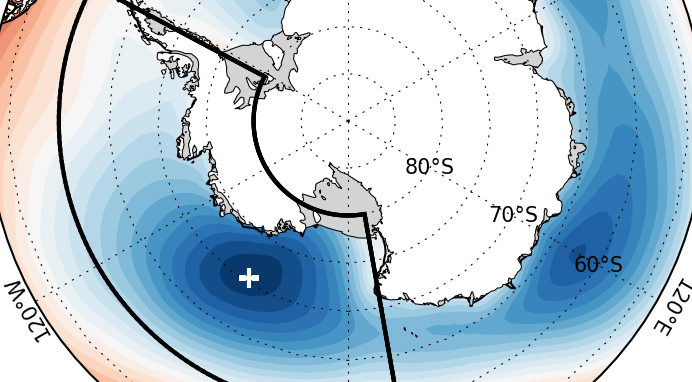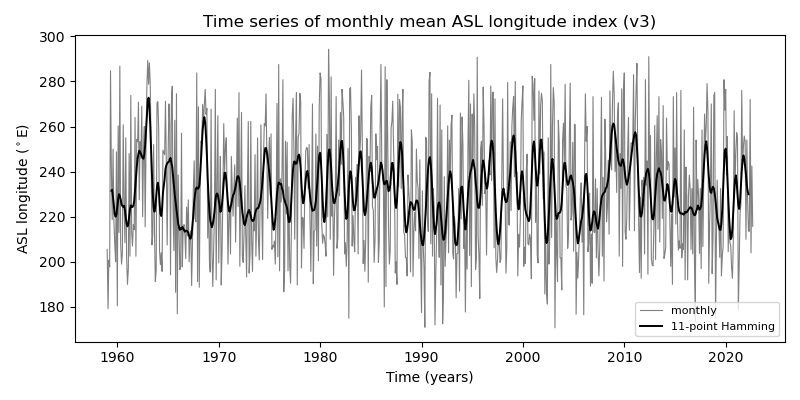The ASL Climate Index

 Over
the last few decades, West Antarctica has experienced rapid environmental change.
Observed spatial trend patterns in surface temperature and sea ice extent indicate that these
are likely to be linked to changes in the Amundsen Seas Low (ASL): a highly
dynamic and mobile climatological low pressure system located in the
Pacific sector of the Southern Ocean. In this sector, variability in
sea-level pressure is greater than anywhere in the Southern Hemisphere,
making it challenging to isolate local fluctuations in the ASL from
larger-scale shifts in atmospheric pressure.
In Hosking et
al., 2013* we demonstrated that the position and strength of
the ASL are crucial for understanding regional change over West Antarctica.
Furthermore, the state-of-the-art climate models which best simulate
the ASL produce a better representation of the regional surface climate.
Over
the last few decades, West Antarctica has experienced rapid environmental change.
Observed spatial trend patterns in surface temperature and sea ice extent indicate that these
are likely to be linked to changes in the Amundsen Seas Low (ASL): a highly
dynamic and mobile climatological low pressure system located in the
Pacific sector of the Southern Ocean. In this sector, variability in
sea-level pressure is greater than anywhere in the Southern Hemisphere,
making it challenging to isolate local fluctuations in the ASL from
larger-scale shifts in atmospheric pressure.
In Hosking et
al., 2013* we demonstrated that the position and strength of
the ASL are crucial for understanding regional change over West Antarctica.
Furthermore, the state-of-the-art climate models which best simulate
the ASL produce a better representation of the regional surface climate.
* In Hosking et al. (2013) we used the term Amundsen-Bellingshausen Seas Low (ABSL).
However, following a dedicated
ASL
workshop, the term Amundsen Sea Low (ASL) is now used for our more recent publications.
ASL Indices
 The ASL indices are defined as follows:
The ASL indices are defined as follows:
The ASL latitude and longitude are identified using a minima finding algorithm within the ASL sector (170°—298° E, 80°—60° S). This dataset is derived using monthly ERA5 mean sea level pressure data (see notebook).
The ASL Actual Central Pressure Index is simply defined as the pressure at the ASL location. Note that the ASL actual central pressure is strongly modulated by the Southern-Hemisphere Annual Mode (SAM) across all seasons, with time series correlations significant at p<0.01 (Hosking et al., 2013). For this reason we derive an alternative measure called the Relative Central Pressure.
The ASL Relative Central Pressure is essentially a regional pressure anomaly. It is calculated by subtracting the ASL actual central pressure from the area-averaged pressure over the ASL domain (domain specified above).
Data
ASL indices derived from monthly ERA5 reanalysis data
- Data* (csv, 1959-01 to 2024-05**)
- Code (GitHub repo)
- Pressure maps with ASL locations (view pdf via GitHub)
- Timeseries (png)
These indices are defined using an ASL detection methodology very similar to that described in Hosking et al. (2016) although (rather than IDL) it is now written in Python. Therefore, this methodology and any associcated indices/derived data will be henceforth referred to as 'version 3' (or 'v3') as the method is non-identical to the previous one (version 2). Versions 1 and 2 of the ASL indices (which were in any case derived on ERA-Interim reanalysis data, and not ERA5) can be found on our legacy webpage.
To compare v3 against v2, I have written a python notebook where the ASL indices are derived from ERA-Interim data to match the methodology in Hosking et al. (2016).
Citation
Hosking, J. S., Orr, A., Bracegirdle, T. J., Turner, J. (2016). Future circulation changes off West Antarctica: Sensitivity of the Amundsen Sea Low to projected anthropogenic forcing.. Geophysical Research Letters, 43, doi:10.1002/2015GL067143
*It is recommended that users visually inspect the selected ASL locations with regards to the pressure fields before trusting and publishing any findings. See green plus symbols'+' for each month here.**Feel free to get in contact if you require the ASL index (v3) to be updated